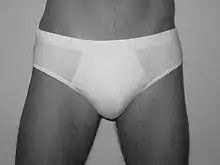Crotch
In humans, the crotch is the bottom of the pelvis (the region of the body where the legs join the torso) and is often considered to include the groin and genitals.
Etymology
Crotch is derived from crutch; it was first used in 1539 to refer to a forked stick used as a farm implement.[1] This region of the body is also described with other terms such as groin or the lower ventral area.[2]
In clothing
In clothing, the crotch is the area of trousers, shorts, leggings etc. where the legs join. The bottom of the crotch is an end of the inseam. The crotch-region on smaller garments such as underwear are sometimes referred to as the pouch.[3] Loosely-fitted or bagginess in the crotch-region is sometimes associated with a lax, casual and easy-going approach to attires or garbs.[4]
Clothing that is tight-fitting in the crotch produces an effect that is sometimes referred to by informal terms such as a man-bulge [5] or moose-knuckle [6] on men, and a camel toe on women, especially if the woman's labia majora are conspicuous.[7] Prolonged constrictive pressure of the crotch on the male genitals may increase the likelihood of detumescing.[8]
Scope
The semantic field of the term crotch is sometimes expanded to include objects which have a similar shape to the anatomical human crotch.[9] This may include botanical structures such as the area where tree branches are joined together[10] or mechanical structures which fork or branch or where ramification takes place.[11] The term had also been expanded to include the joining together of asymmetrical surfaces in cue sports equipment or the corners of flat surfaces usually made of quarried slate.[12]
Depictions in artwork
The human crotch has been depicted in artwork. In Paleolithic art, forms called tectiforms or quadrilaterals have sometimes been interpreted to be "quick visual guides, reminders to the imagination" of the female crotch, and typically do not represent the crotch hairs.[13]
Classical marble statues depict females without pubic hair; in contrast, statues of males "show curly pubic hair".[14]
For much of the history of European art – "until the late seventeenth century" – references to the female crotch were approached from above: "Art usually expressed the sense of the vulva as a point at the bottom of the belly rather than as the meeting place at the top of the thighs."[15]
Art therapists have noted "a triangular or vaginal shaped area in drawings by rape/sexual abuse victims".[16]
References
- Hodgson, Charles. 2007. Carnal Knowledge: A Navel Gazer's Dictionary of Anatomy, Etymology, and Trivia, New York: St. Martin's Press. page 175.
- Stavros, A. Thomas; Rapp, Cindy (September 2010). "Dynamic ultrasound of hernias of the groin and anterior abdominal wall". Ultrasound Quarterly. 26 (3): 135–169. doi:10.1097/RUQ.0b013e3181f0b23f. PMID 20823750. S2CID 31835133.
- Davis, Sheena, and Alistair Furnell. Personal Equipment and Clothing Correction Factors for the Australian Army: A Pilot Survey. No. DSTO-TR-3044. Defence Science and Technology Organisation Fishermans Bend (Australia) Land Div., 2014.
- Elizabeth, Newcomb; Istook, Cynthia (September 2011). "Confronting stereotypes: apparel fit preferences of Mexican-American women". Journal of Fashion Marketing and Management. 15 (4): 389–411. doi:10.1108/13612021111169915.
- Harris, Michael. "If Clement isn't fit for caucus, why is he fit to be anyone's MP?". IPolitics. Archived from the original on April 17, 2019. Retrieved January 19, 2019.
It took Weiner a full 20 days to realize he had to resign after a photo of "his man bulge in boxer briefs" hit Twitter on May 27, 2011.
- Schlosser, Bethanee J., and Ginat W. Mirowski. "Approach to the patient with vulvovaginal complaints." Dermatologic therapy 23.5 (2010): 438–448.
- Alapack, Richard J. "The epiphany of female flesh: A phenomenological hermeneutic of popular fashion." The Journal of Popular Culture 42.6 (2009): 977–1003
- Dunlap, Knight. "The development and function of clothing." The Journal of General Psychology 1.1 (1928): 64–78
- Widdowson, Henry G. "Aspects of the relationship between culture and language." Communication interculturelle et apprentissage des langues. Triangle 7 (1988).
- Shigo, Alex L. "How tree branches are attached to trunks." Canadian Journal of Botany 63.8 (1985): 1391–1401.
- Zhang, L. "Thermal Deformation Modelling Attempt Of A Storage Ring Vacuum Vessel." Proceedings of EPAC, Vienna, Austria (2000): 2486–2488.
- Byrne, Robert. Byrne's new standard book of pool and billiards. Houghton Mifflin Harcourt, 1998.
- Guthrie, R. Dale. 2006. The Nature of Paleolithic Art, University of Chicago Press, pp. 357–358. ISBN 9780226311265
- Morris, Desmond. 2007. The Naked Woman: a study of the female body. Macmillan. page 196. ISBN 9780312338534
- Hollander, Anne. 1993. Seeing Through Clothes, University of California Press. p. 220. ISBN 9780520082311
- Coleman, Victoria D. and Phoebe M. Farris-Dufrene. 1996. Art Therapy and Psychotherapy: Blending Two Therapeutic Approaches, Taylor & Francis. p. 39. ISBN 9781560324898

